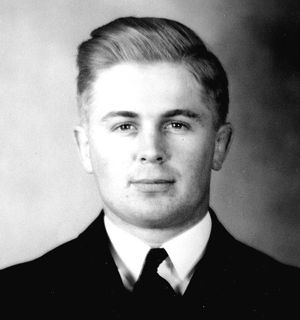
Naval History & Heritage Command photo 80-PA-1A-22.
Ens. Samuel Adams, USN.
Following sea duty in the battleships West Virginia (BB-48) (28 June to 19 July 1935), and Tennessee (BB-43) (19 July 1935 to 2 January 1938), Adams underwent flight instruction at the Naval Air Station. Pensacola, Florida, and was designated a naval aviator on 17 January 1939. Promoted to lieutenant (j.g.) soon thereafter, he served a brief tour of duty in the Saratoga (CV-3) air group from 12 April to 12 May 1939, before he was assigned to Bombing Squadron (VB) 5, attached to the aircraft carrier Yorktown (CV-5) on 13 May 1939.
Yorktown, to which VB-5 was attached, operated with the Pacific Fleet until the spring of 1941, when she was transferred to the Atlantic. Early in this period, VB-5 operated off Ranger (CV-4) as VB-5 and other Yorktown squadrons exchanged with units from that carrier, carried out neutrality patrols in the North Atlantic. Adams remained with the squadron through its transition at Norfolk from the Northrop BT-1 to the famous Douglas SBD “Dauntless,” and flew patrols from Yorktown when that carrier covered convoys in the North Atlantic in the fall of 1941.
Soon after Pearl Harbor, Yorktown returned to the Pacific and took part in the raids on Japanese advanced bases in the Marshalls and Gilberts. Adams, by that time one of the more senior pilots in the group, led a section of SBDs from VB-5 in raids on Japanese shipping and installations at Jaluit on 1 February 1942. A little over a month later, he again led a section in the combined Yorktown–Lexington (CV-2) air group strike on Japanese shipping off Lae and Salamaua, New Guinea, on 10 March 1942. He also led sections in the raids on Tulagi (4 May 1942) and in the Battle of the Coral Sea (7 and 8 May 1942). For his performance in those engagements in the first six months of the war, he received two Navy Crosses.
Although VB-5 had performed arduous duty in the early wartime period, the circumstances prevailing shortly before the Battle of Midway meant that there would be no rest for it. Temporarily redesignated as “Scouting” Squadron 5, VB-5 returned to the fray in Yorktown, which had been hastily repaired after being damaged in the Coral Sea.
During the action at Midway on 4 June 1942, dive bombers from Yorktown and Enterprise (CV-6) mortally damaged three of the Japanese striking force’s four carriers. Adams and his wingman, Lt. Harlan R. Dickson, were among the VB-5 pilots assigned a search sector in the effort to locate Hiryu, the one carrier left undamaged.
They found their quarry, and though Adams and Dickson were attacked by a “Zero” fighter, Adams radioed a precise contact report which enabled a striking group of planes from Enterprise—including those from Yorktown’s orphaned VB-3—to locate Hiryu and score hits that knocked her out of the battle and led to her ultimate abandonment.
The next afternoon, while flying a search mission from Enterprise, Adams spotted the Japanese destroyer Tanikaze. As he began his dive, he urged his wingmen to take their time in order to make accurate attacks. His SBD dove into the cloud cover, and was never seen again. Adams and his radioman, Aviation Radioman 1st Class Joseph J. Karrol, fell to the destroyer’s antiaircraft fire.
For his significant role in the Battle of Midway, Adams was posthumously awarded a third Navy Cross.